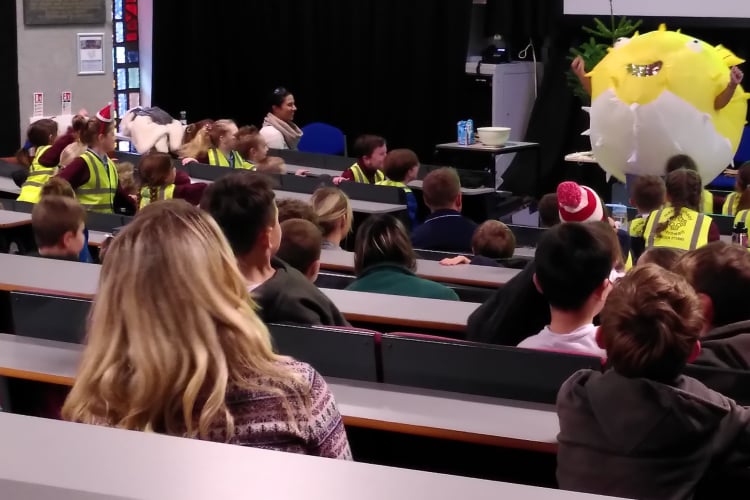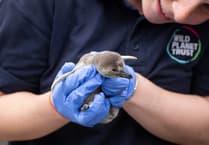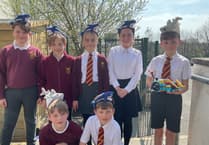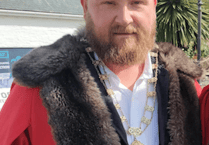A trio of magical stories from the worlds of science and engineering have been shared with schoolchildren as part of an annual festive tradition.
The mystery of how dragonflies reach Christmas Island, the remarkable power of the planet’s wind, and a story of a pufferfish and plastic pollution enraptured the young audience at this year’s Science of Christmas event.
Around 170 children travelled to the Penryn campus from five primary schools in the villages of Flushing, Ponsanooth, Mabe, Mylor Bridge and Perranwell.
Over the course of an hour, they heard from researchers and graduates at the University, who shared with them some planetary wonders with a Christmas twist.
The Christmas Island Mystery was told by Dr Johanna Hedlund, Swedish Research Council Formas Fellow in the Centre for Ecology and Conservation, and an expert in the migration of insects – particularly dragonflies.

Dr Hedlund said: “Christmas Island is, unlike what its names implies, not a snowy place close to the North Pole, but a small tropical island, isolated in the Indian Ocean.
“Every spring, thousands of dragonflies arrive to this isolated place, where very little fresh water is available. It is a mystery why they come to the island, as they need freshwater to lay their eggs. And it is a mystery where they go afterwards, as they leave just as suddenly.”
Dr Hedlund’s research is exploring where the dragonflies travel to, and how they get there – with one theory that they glide on seasonal winds to extend their range much further than they could through flight alone.
University graduates Amy Bray and Maddie Kirby, from the youth-led environmental education charity Another Way, delivered their talk titled The Pufferfish who Saved Christmas. Another Way is a youth-led environment education charity that delivers inspiring workshops for young people in Cornwall and beyond, with a focus on empowering people to be more considerate towards the planet.
Dressed as an inflatable Earth and a pufferfish, Amy and Maddie took the children on a journey to identify the hidden plastic culprits at Christmas, and how they can end up in the ocean and break down into microplastics. The children were then able to get hands-on with some potential solutions, including making their own plastic-free glitter, and decorating a Christmas tree with plastic-free, homemade decorations.

The third talk, Santa’s Secret Helper: The Power of Wind!, was delivered by Dr Faryal Khalid, Lecturer in Offshore Renewable Energy, and explained how wind energy is playing a vital role in lighting up Christmas displays. Dr Khalid explained how one-third of the UK’s electricity is now generated from wind energy, meaning iconic light displays including those at Mousehole, Angarrack, and The Lost Gardens of Heligan are now partly powered by green energy.
Dr Khalid, whose research focuses on the design of offshore wind turbine support structures, told the audience how the largest wind turbine has a rotor diameter measuring four times the height of Truro Cathedral’s spires, and demonstrated the technology using a model turbine.
Alex Thornton, professor of cognitive evolution in the Centre for Ecology and Conservation, said: “The Science of Christmas has become a proud festive tradition for the University, and it was great to see so many young minds engrossed in this year’s stories.
“And these events play an important role in our community and civic engagement, because they bring local children and their teachers onto campus, where they can see and hear for themselves how the knowledge and expertise in our academic community is helping to make a difference in today’s world.”





Comments
This article has no comments yet. Be the first to leave a comment.